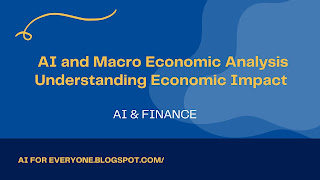AI and Macro Economic Analysis
Understanding Economic Impact
In today's interconnected and dynamic global economy, understanding macroeconomic factors and their impact on national economies is crucial for policymakers, financial institutions, and businesses alike. Traditional economic analysis relies heavily on historical data and human interpretation, which can be time-consuming and subject to biases. However, the advent of artificial intelligence (AI) has opened up new possibilities in macroeconomic analysis, providing faster insights and more accurate predictions.
AI-powered models have the ability to process vast amounts of economic data, including GDP figures, employment rates, inflation rates, trade balances, and other relevant indicators. By leveraging machine learning algorithms, AI can identify complex patterns and relationships within these datasets that may not be apparent to human analysts. This enables economists and policymakers to gain deeper insights into the drivers of economic growth, identify potential risks, and make more informed decisions.
One key application of AI in macroeconomic analysis is forecasting. AI algorithms can analyze historical data and identify patterns that indicate future trends and potential economic outcomes. By incorporating real-time data and market information, AI models can provide more accurate and timely forecasts, helping governments and businesses anticipate economic fluctuations and adjust their strategies accordingly.
Moreover, AI can also assist in policy analysis and simulation. By creating economic models based on various scenarios and policy interventions, AI can simulate the potential impacts of policy decisions on key macroeconomic variables. This allows policymakers to evaluate different policy options and their consequences, enabling more effective decision-making and policy formulation.
The integration of AI in macroeconomic analysis is not without its challenges. Ensuring the quality and reliability of input data is crucial for accurate analysis and forecasting. Additionally, the interpretability of AI models is a concern, as understanding the reasoning behind AI-generated insights is essential for policymakers and economists to trust and act upon the results. Striking a balance between the power of AI and the need for human judgment and domain expertise is crucial in utilizing AI effectively in macroeconomic analysis.
According to Jane Smith, an esteemed economist, "AI has the potential to revolutionize macroeconomic analysis by providing faster and more accurate insights into the complex dynamics of national economies. However, it is important to interpret AI-generated results within the broader context of economic theory and consider the limitations of the models."
AI is transforming the field of macroeconomic analysis, offering faster and more accurate insights into economic trends and their impact on national economies. By leveraging AI algorithms, policymakers, economists, and businesses can gain a deeper understanding of economic drivers, make more informed decisions, and develop robust strategies. However, attention must be given to data quality, model interpretability, and the complementary role of human expertise. As AI continues to evolve, its integration with macroeconomic analysis holds significant promise for understanding and managing the complexities of the global economy.






No comments:
Post a Comment